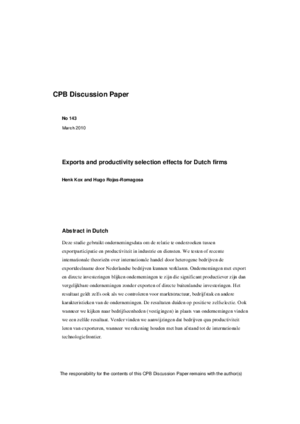Exports and productivity selection effects for Dutch firms
Self-selection based on productivity drives export decision Dutch firms
This self-selecting behaviour is strongest for small and medium-sized enterprises (SMEs). The effect is also stronger in manufacturing than in services.
These are the main conclusions drawn by Henk Kox and Hugo Rojas-Romagosa in the CPB Discussion Paper 143 'Exports and productivity selection effects for Dutch firms', published today.
Fixed entry costs in export markets lead to self-selection
This study deals with the question why exporting firms are more productive than their non-exporting competitors in the domestic market. Have they become more productive by exporting or did they start exporting because they are more productive? The report proves that the latter is true. Dutch firms that switch to exporting in year t were already more productive than comparable non-exporting competitors in the home market two to three years before year t.
The explanation for this "self-selection into exporting" can be found in the fixed entry costs in foreign markets. Fixed export costs are typically caused by differences in regulations, language, business culture, and by one-off costs for information gathering, setting up distribution networks and marketing. In order to absorb such costs and still make a profit from exporting the firms need a higher productivity. Those firms that feel ill-equipped to absorb high export costs, remain only active in the home market. New exporters were found to have a labour productivity advantage of 12 per cent compared to the non-exporting firms in the domestic market two to three years before starting exporting.
Self-selection strongest for SMEs in manufacturing
The outcomes appear to be robust after controlling for differences in knowledge intensity, market structure, industrial sector and other firm characteristics. The report shows that the self-selection findings not only hold at the firm level, but also at the plant or establishment level. The role of self-selection appears to be significantly stronger for SMEs (less than 250 employees) than for larger firms. This result makes sense if one considers that fixed export costs do not vary very much by firm size, so that they press relatively more heavily for SMEs. Based on the average productivity advantage of new exporters, we derive that the impact of fixed export costs is substantially larger in manufacturing compared to services.
Domestic productivity gains due to export learning?
The researchers have found no evidence that firms, generally speaking, experience domestic productivity gains because of foreign learning effects after they have started exporting. An exception appears to hold for firms which - at the moment of their export start - operated a technology that was far from the international efficiency standards. For those relatively inefficient exporters, a positive productivity effect emerged three years after the export started, both in services and in manufacturing.
Importance of multinationals
Finally, the study yields new facts about the firm-level structure of Dutch exports and especially about the large role played by multinational firms. If manufacturing exporters are ranked by export size, the five per cent biggest exporters together account for 73 per cent of total manufacturing exports. And three-fifths of these 73 per cent is supplied by firms that are associated with Dutch-owned multinationals. Manufacturing exports are thus strongly concentrated with a relatively small number of large firms. Export concentration in services is somewhat less pronounced compared to in manufacturing.
This study presents recently available data on the microstructure of Dutch exports and the relation between export participation and productivity at the firrm and establishment-level. We test whether recent theories of international trade with heterogeneous firms can explain the patterns in the Dutch data.
We find significant evidence that firms self-select into export participation, even after controlling for sector and firm-specific characteristics. In general, only the most productive Dutch firms participate in exports and foreign direct investment.
In addition, we find evidence for the learning-by-exporting hypothesis once we control for the firm's distance to the international productivity frontier.
Background document: CPB Memorandum 250
